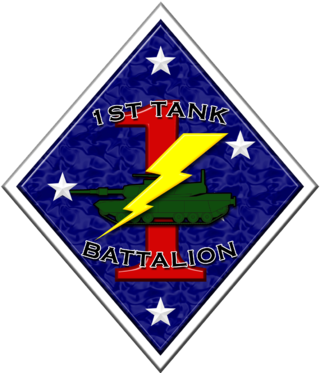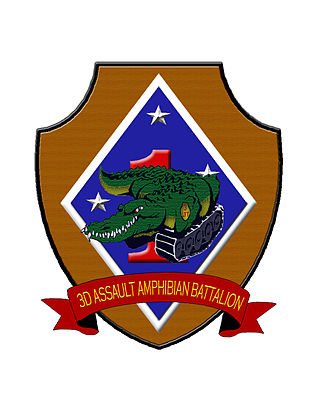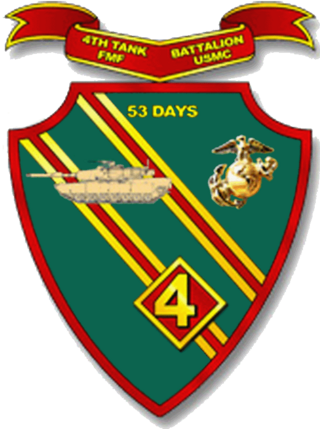
The 3rd Marine Division is a division of the United States Marine Corps based at Camp Courtney, Marine Corps Base Camp Smedley D. Butler in Okinawa, Japan. It is one of three active duty infantry divisions in the Marine Corps and together with the 1st Marine Aircraft Wing (1stMAW) and the 3rd Marine Logistics Group forms the III Marine Expeditionary Force. The division was first formed during World War II and saw four years of continuous combat in the Vietnam War. Today, elements of the 3rd Marine Division are continuously forward deployed and forward postured to carry out the US Government's mission of a Free and Open Indo-Pacific in conjunction with its sister services.

The 4th Marine Division is a reserve division in the United States Marine Corps. It was raised in 1943 for service during World War II, and subsequently fought in the Pacific against the Japanese. Deactivated after the war, the division was re-formed in 1966 and elements of the division deployed during the Gulf War in 1990–1991, as well as during the Iraq War. It is currently the ground combat element of the Marine Forces Reserve and is headquartered in New Orleans, Louisiana, and has units throughout the United States.

The 5th Marine Division was a United States Marine Corps ground combat division which was activated on 11 November 1943 at Camp Pendleton, California during World War II. The 5th Division saw its first combat action during the Battle of Iwo Jima in 1945 where it sustained the highest number of casualties of the three Marine divisions of the V Amphibious Corps. The 5th Division was to be part of the planned invasion of the Japan homeland before Japan surrendered. Assault troops of the 5th Division were included in the Presidential Unit Citation awarded to the V Amphibious Corps for extraordinary heroism on Iwo Jima from 19 to 28 February 1945. The 5th Division was deactivated on 5 February 1946.

The 5th Marine Regiment is an infantry regiment of the United States Marine Corps based at Marine Corps Base Camp Pendleton, California. It is the most highly decorated regiment in the Marine Corps and falls under the command of the 1st Marine Division and the I Marine Expeditionary Force.

The 1st Tank Battalion was an armor battalion of the United States Marine Corps which was based out of the Marine Corps Air Ground Combat Center Twentynine Palms, California. It last fell under the command of the 1st Marine Division and I Marine Expeditionary Force. The unit was decommissioned in May 2021 as part of the service Force Design 2030 initiative which saw it move away from larger armor formations.

The 25th Marine Regiment is one of two infantry regiments in the 4th Marine Division of the United States Marine Corps. From its headquarters in Fort Devens, Massachusetts, the regiment commands fifteen training centers in nine states throughout the Northeast. These units consist of approximately 3,500 reserve and active duty Marines and are located from Maine to Delaware, West Virginia and as far west as Ohio. The 25th Marines is primarily a cold weather regiment and frequently trains in northern Norway.

The 3rd Reconnaissance Battalion conducts amphibious and ground reconnaissance in support of the 3rd Marine Division and Marine Forces Pacific (MarForPac), operating in the commander's areas of influence. The battalion is based out of Camp Schwab, a satellite base of Marine Corps Base Camp Smedley D. Butler. It is geographically located on the Okinawa Prefecture in Japan.

3rd Assault Amphibian Battalion is one of two active duty assault amphibian battalions in the United States Marine Corps. The battalion is tasked with transporting US Marine forces and their equipment from assault ships to shore, and equipped with the Amphibious Combat Vehicle (ACV), which replaced the Amphibious Assault Vehicle (AAV). The battalion is part of the 1st Marine Division and the I Marine Expeditionary Force. The unit is based in Camp Pendleton in California.

3rd Battalion, 24th Marines (3/24) was a reserve infantry battalion in the United States Marine Corps. The battalion was first formed in 1943 for service in the Pacific Theater of Operations during World War II, taking part in a number of significant battles including those at Saipan and Iwo Jima before being deactivated at the end of the war. In the early 1960s, the unit was reactivated as a reserve battalion. It was located throughout the Midwestern United States and consisted of approximately 800 marines and sailors. The battalion was part of the 24th Marine Regiment and the 4th Marine Division. Recent operations included tours in Iraq and Afghanistan. On May 19, 2013, the battalion was deactivated (retired) as a part of 2013 Marine Corps Force Restructuring, along with the 24th Marine Regiment. 3/24 personnel were reallocated to 23rd Marine Regiment, with the majority of the companies becoming 3rd Battalion, 23rd Marines.

4th Tank Battalion was an armored battalion of the United States Marine Corps Reserve. Their primary weapon system was the M1A1 Abrams main battle tank and they were part of the 4th Marine Division and Marine Forces Reserve. The unit headquarters was at the Navy and Marine Corps Reserve Center San Diego, California, but other units in the battalion were located throughout the United States. Until the decision to divest the Marine Corps' armor capability, 4th Tank Battalion was the largest tank battalion in the US military with six lettered companies and an H&S Company.

The 9th Marine Regiment was an infantry regiment of the United States Marine Corps. Formed during World War II, it served until 1994, when it was deactivated during the post Cold War drawdown. Battalions of the Ninth Marine Regiment, but not the regiment itself, were reactivated from 2007 to 2014 as part of the Marine Corps' growth during the wars in Iraq and Afghanistan. The battalions have subsequently been deactivated again.

The 1st Battalion 9th Marines (1/9) was an infantry battalion of the United States Marine Corps. Formed during World War I, it served until the mid-2000s when it was deactivated to make room for one of three light armor reconnaissance battalions. During the Vietnam War, 1/9 sustained an especially high casualty rate as they faced extraordinary challenges and hardships during their tour. General Vo Nguyen Giap promised President Ho Chi Minh that he would wipe out the 1st Battalion, 9th Marines, as a present for the leader’s birthday. In describing the fate that awaited the Marines in the valley, Giap allegedly used the term "Di Bo Chet", translated as the “Walking Dead”. He viewed that the Marines should be considered already dead, just not buried yet. However, 1st Battalion, 9th Marines, proudly and defiantly adopted “The Walking Dead” as its nickname due to the unit's persistence and resilience.

Combat Logistics Regiment 3 (CLR-3) is a direct support (DS) logistics unit of the United States Marine Corps and is headquartered at Camp Foster, Okinawa, Japan. The unit falls under the 3rd Marine Logistics Group and the III Marine Expeditionary Force.

The 3d Medical Battalion is a medical support unit of the United States Marine Corps and is headquartered at Camp Foster, Okinawa, Japan. The unit falls under the command of 3rd Marine Logistics Group.

1st Battalion, 12th Marines (1/12) was an artillery battalion comprising three firing batteries and a Headquarters Battery. The battalion was stationed at Marine Corps Base Hawaii and fell under the 12th Marine Regiment and the 3rd Marine Division. It was deactivated on 26 May 2023.

The Combat Assault Battalion was a mechanized battalion of the United States Marine Corps and subordinate element of the 3rd Marine Division and the III Marine Expeditionary Force. The unit was last based at Camp Schwab, Okinawa, Japan.

2nd Battalion, 9th Marines (2/9) was an infantry battalion of the United States Marine Corps. Formed during World War I, the unit played an instrumental role in the defeat of the Japanese forces in the Battles of Guam and Iwo Jima during World War II. The battalion distinguished itself in the defense of Khe Sanh during the Vietnam War, and later participated in an ill-fated invasion of Koh Tang Island in Southeast Asia, with the intention of rescuing the crew of SS Mayaguez. During Operation Desert Storm, the battalion served as the lead battalion for the III Marine Expeditionary Force.

The 3rd Battalion, 9th Marines (3/9) is an infantry battalion of the United States Marine Corps. Formed during World War I it served until the early 1990s when it was redesignated as 3rd Battalion, 4th Marines (3/4) during a realignment and renumbering of the Marine Corps' infantry battalions, following the deactivation of the 9th Marine Regiment. The 3rd Battalion, 9th Marines was initially a subordinate unit of the 9th Marine Regiment, 3rd Marine Division, but was later operationally transferred to the 1st Marine Division as a subordinate unit of the 7th Marine Regiment where it remained until its redesignation as 3/4.

The 28th Marine Regiment is an infantry regiment of the United States Marine Corps. The regiment, which is part of the 5th Marine Division, fought in the Battle of Iwo Jima during World War II. Six Marines of the 2nd Battalion, 28th Marines were featured in the historical photo by Joe Rosenthal of the U.S. flag raising on top of Mount Suribachi.

Frank Edmund Garretson was an American military officer who served in the United States Marine Corps with the rank of brigadier general. A veteran of World War II, he distinguished himself as commanding officer of Company F, 2nd Battalion, 24th Marines, 4th Marine Division during the attack on Namur Island, Kwajalein Atoll, on February 1–2, 1944 and received the Navy Cross, the United States' second-highest decoration awarded for valor in combat.


























